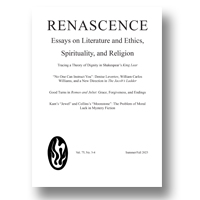|
1.
|
Renascence:
Volume >
73 >
Issue: 4
Ed Block
Friendship, Renunciation, and a Celebration of the Transcendent Self:
Willa Cather’s Death Comes for the Archbishop after One Hundred Years
abstract |
view |
rights & permissions
| cited by
As Death Comes for the Archbishop approaches one hundred years of critical scrutiny, it still speaks to readers in much the same way it did in the 1920s. A critical response to early twentieth-century materialism and mendacity, the story of nineteenth-century New Mexico Archbishop Jean Marie Latour and his friend and Vicar, Fr. Joseph Vaillant affirms as it dramatizes friendship and renunciation while simultaneously celebrating the centrality of the transcendent self and the richness and value of lived personal experience.
|
|
|
2.
|
Renascence:
Volume >
73 >
Issue: 4
Elizabeth Theresa Howe
San Juan de la Cruz and the Cántico Espiritual:
The Soul in Transit; the Mystic on the Move
abstract |
view |
rights & permissions
| cited by
The predominant imagery of progress in western mystical writing usually describes some form of ascent. The Subida del monte Carmelo by San Juan de la Cruz certainly suggests the notion in Spanish mystical writing. While San Juan proffers ascent (subida) in the title of the commentary on “En una noche oscura,” the poem proper does not present a sense of verticality at all but, rather, an essentially horizontal passage from the “casa sosegada” to (re)union with the Lover in a static apotheosis described in the final strophes. Similarly, a paradoxical presentation of movement appears in the Cántico espiritual. This article considers San Juan’s use of verbs of movement, especially within the Cántico espiritual, as metaphors for the underlying mystical message he ascribes to his poem. It also demonstrates the presence of the same extended metaphor in other poems of his, including “En una noche oscura” and the “Llama de amor viva.
|
|
|
3.
|
Renascence:
Volume >
73 >
Issue: 4
Bruce W. Young
‘Upon Such Sacrifices’: Atonement and Ethical Transcendence in King Lear
abstract |
view |
rights & permissions
| cited by
Though the word "atonement" does not appear in King Lear, the concept is present, along with related ones, like sin, justice, redemption, and sacrifice. Like other plays, Lear alludes to various atonement theories, setting them in dramatic conflict or cooperation and subjecting some to critique. Besides revealing the inadequacy of models based on payment or punishment, the play reinterprets the sacrificial theory of atonement by presenting sacrifice (especially that of Cordelia) as gracious and redemptive self-offering, not as a punishment or payment that satisfies anger or offended honor. Though the play’s religious references, including to Christ, are pervasive, ultimately atonement takes place at a human level, in the healing of relationships and inner maladies. Yet such atonement involves what may be called “ethical transcendence,” a transcendence consisting not in an ascent beyond the human condition, but rather in the offering of oneself in relationship and service to others.
|
|
|
4.
|
Renascence:
Volume >
73 >
Issue: 4
Samuel Hazo
War as Pornography
abstract |
view |
rights & permissions
| cited by
Pornography has been defined as sex separated from personality. In other words, life’s deepest need to express desire and affection and perpetuate the species is reduced to appetite and the satisfaction of appetite. War in many ways does the same. It depersonalizes killing by pitting stranger against stranger—uniformed or otherwise. Fatalities are reduced to numbers. Such killings are dignified by slogans (“Vietnamizing the Vietnamese” or “Operation Iraqi Freedom”),. Preparing troops for the killings in war is everything from oratory to close order drill, parades and honors. Denis de Rougemont in LOVE IIN THE WESTERN WORLD has even traced this to the legend of Tristan and Isolde in which Tristan chooses a military life to define his manhood after leaving Isolde. All of these manifestation and pretenses gloss over the brutality of war just as films, photographs and other promotions disguise pornography as mere excitement.
|
|
